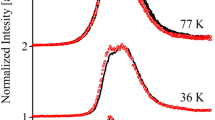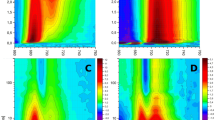Abstract
The energy exchange between antenna chlorophylls of the monomeric subunits within a Photosystem I trimeric complex of the cyanobacterium Spirulina was studied, comparing the kinetics of the light-induced decrease of Photosystem I fluorescence at 760 nm, emitted by the longwave chlorophyll absorbing at 735 nm and P700 photooxidation. Both kinetics have been measured at 77 K simultaneously using a fiberoptic system. The light-induced decrease of fluorescence at 760 nm in trimers was faster than P700 oxidation, although the decrease of fluorescence at 760 nm was ascribed to the quenching effect of oxidized P700 that is a stronger quencher of fluorescence at 760 nm than P700 reduced [Shubin et al. (1995) J Photochem. Photobiol 27B: 153–160]. The proportionality of the reciprocal value of the half time for the fluorescence decrease at 760 nm in trimers to the light intensity indicates the photochemical nature of the fluorescence quenching. The nonlinear relationship between the variable part of fluorescence at 760 nm and the fraction of reduced P700 is considered to be a result of an energetic connectivity of the antennae of monomeric subunits within a trimer. When one P700 in PS I trimers of Spirulina is oxidized, the energy from an antenna of monomeric subunit(s) with reduced P700 may migrate to a subunit with oxidized P700 and quenched there. This may explain the slower rate of P700 photooxidation in trimers as compared with monomers. The analytical description of cooperativity processes in Photosystem I coincides well with the measured data. A model is presented describing the energetic interaction of chlorophyll antennae of monomeric subunits within the trimer via the extreme long-wavelength chlorophyll form. This intersubunit interaction may stimulate the dissipation of excess energy as heat and, therefore, protect the pigment–protein complex against photodestruction.
Similar content being viewed by others
References
Borisov AY and Ilina MD (1973) The quantum yield of reaction center photooxidation in subchloroplast fragments enriched with Photosystem I. Biochim Biophys Acta 325: 240–246
Butler WL (1978) Energy distribution in the photochemical apparatus of photosynthesis. Annu Rev Plant Physiol 29: 345–378
Clayton RK (1967) An analysis of the relations between fluorescence and photochemistry during photosynthesis. J Theor Biol 14: 173–186
Deinum G, Kramer H, Aartsma TJ, Kleinherenbrink FAM and Amesz J (1991) Fluorescence quenching in Heliobacterium chlorum by reaction centers in the charge separated state. Biochim Biophys Acta 1058: 339–344
Delepelaire P and Bennoun P (1978) Energy transfer and site of energy trapping in Photosystem I. Biochim Biophys Acta 502: 183–187
Duval JC, Thomas JC and Choquet Y (1986) 77 K fluorescence quenching induced by reduction of Photosystem I primary electron acceptors in a cyanobacterium. Biochim. Biophys Acta 848: 352–358
Fork DC and Amesz J (1967) Energy transfer between photosynthetic units of system I in algae. Biochim Biophys Acta 143: 266–268
Garlaschi FM, Karapetyan NV, Cometta A, Zucchelli G and Jennings RC (1998) Longwavelength absorption forms in Spirulina PS I trimers. In: Garab G (ed) Photosynthesis: Mechanisms and Effects, Vol I, pp 417–420. Kluwer Academic Publishers, Dordrecht, The Netherlands
Golbeck JH (1994) Photosystem I in cyanobacteria. In: Bryant DA (ed) The Molecular Biology of Cyanobacteria, pp 319–360. Kluwer Academic Publishers, Dordrecht, The Netherlands
Havaux M, Greppin H and Strasser RJ (1991) Functioning of Photosystems I and II in pea leaves exposed to heat stress in the presence or absence of light. Planta 186: 88–98
Jansson S (1994) The light-harvesting chlorophylla/b-binding proteins. Biochim Biophys Acta 84: 1–19
Jennings RC, Zucchelli G, Croce R, Valkunas K, Finzi L and Garlaschi F (1997) Model studies on the excited state equilibrium perturbation due to reaction centre trapping in photosystem I. Photosynth Res 52: 245–253
Joliot A and Joliot P (1964) Etude cinetique de la reaction photochimique liberant oxygen au cours de la photosynthese. C R Acad Sci Paris 258: 4622–4625
Karapetyan NV, Dorra D, Holzwarth AR, Kruip J and Roegner M (1998) The origin of the extreme longwave chlorophyll form of the Photosystem I trimeric complex of Spirulina. In: Garab G (ed) Photosynthesis: Mechanisms and Effects, Vol I, pp 583–586. Kluwer Academic Publishers, Dordrecht, The Netherlands
Karapetyan NV, Dorra D, Schweitzer G, Bezsmertnaya IN and Holzwarth AR (1997) Fluorescence spectroscopy of the longwave chlorophylls in trimeric and monomeric Photosystem I core complexes from the cyanobacterium Spirulina platensis. Biochemistry 36: 13830–13837
Karapetyan NV, Klimov VV and Krasnovsky AA (1973) Light-induced changes in the fluorescence yield of particles obtained by digitonin fragmentation of chloroplasts. Photosynthetica 7: 330–337
Kleinherenbrink FAM, Deinum G, Otte CCM, Hoff AJ and Amesz J (1992) Energy transfer from long-walength absorbing antenna bacteriochlorophylls to the reaction center. Biochim Biophys Acta 1099: 175–181
Klimov VV, Krakhmaleva IN, Shuvalov VA, Karapetyan NV and Krasnovsky AA (1975) Dependence of the fluorescence yield of chloroplasts and chromatophores on the redox state of the reaction centers. Dokl Akad Nauk SSSR (Russ) 221: 1207–1210
Koehne B and Trissl H-W (1998) The cyanobacterium Spirulina platensis contains a long wavelength-absorbing pigment C738(F760) at room temperature. Biochemistry 37: 5494–5500
Kruip J, Karapetyan NV, Terekhova IV and Roegner M (1999) In vitro oligomerization of a membrane protein complexes: Liposome based reconstitution of trimeric Photosystem I from isolated monomers. J Biol Chem 274: 18181–18188
Lavergne J and Trissl H-W (1995) Theory of fluorescence induction in Photosystem II: Derivation of analytical expressions in a model including exciton-radical-pair photosynthetic unit. Biophys J 68: 2472–2492
Mauzerall D and Greenbaum NL (1989) The absolute size of a photosynthetic unit. Biochim Biophys Acta 974: 119–140
Mullet JE, Burke JJ and Arntzen CJ (1980) Chlorophyll proteins of Photosystem I. Plant Physiol 65: 814–822
Pallotin G (1976) Movement of excitations in the photosynthesis domain of Photosystem II. J Theor Biol 58: 237–252
Pålsson L-O, Dekker JP, Schlodder E, Monshouwer R and van Grondelle R (1996) Polarized site-selective fluorescence spectroscopy of the long-wavelength emitting chlorophylls in isolated Photosystem I particles of Synechococcus elongatus. Photosynth Res 48: 239–246
Satoh K, Strasser RJ and Butler WL (1976) A demonstration of energy transfer from Photosystem II to Photosystem I in chloroplasts. Biochim Biophys Acta 440: 337–345
Schreiber U, Klughammer C and Neubauer C (1988) Measuring P700 absorbance changes around 830 nm with a new type of pulse modulation system. Z Naturforsch 43c: 686–698
Schubert W-D, Klukas O, Krauss N, Saenger W, Fromme P and Witt HT (1997) Photosystem I of Synechococcus elongatus at 4 Å resolution: Comprehensive structure analysis. J Mol Biol 272: 741–769
Shubin VV, Bezsmertnaya IN and Karapetyan NV (1992) Isolation from Spirulina membranes of two Photosystem I-type complexes, one of which contains chlorophyll responsible for the 77 K fluorescence band at 760 nm. FEBS Lett 309: 340–342
Shubin VV, Bezsmertnaya IN and Karapetyan NV (1995) Efficient energy transfer to P700 from the long-wavelength antenna chlorophylls in Photosystem I complexes from Spirulina platensis. J Photochem Photobiol 30B: 153–160
Shubin VV, Murthy SDS, Karapetyan NV and Mohanty P (1991) Origin of the 77 K variable fluorescence at 758 nm in the cyanobacterium Spirulina platensis. Biochim Biophys Acta 1060: 28–36
Shubin VV, Sineshchekov VA and Litvin FF (1976) Variable fluorescence of the native forms of chlorophyll at –196 °C. Biophysika (Eng Trans) 21: 785–787
Shubin VV, Tsuprun VL, Bezsmertnaya IN and Karapetyan NV (1993) Trimeric forms of the Photosystem I reaction center complex pre-exist in the membranes of the cyanobacterium Spirulina platensis. FEBS Lett 334: 79–82
Sironval C, Strasser RJ and Brouers M (1984) The bioenergetic description of light energy migration in photoactive membranes; equivalence between the theory of the energy fluxes and the theory of the relationship of pigment proportions to total pigments. In: Sironval C and Brouers M (eds) Protochlorophyllide Reduction and Greening, pp 307–316. Martin Nijhoff/Junk Publishers, The Hague
Strasser RJ (1973) Induction phenomena in green plants when the photosynthetic apparatus starts to work. Arch Internat Physiol Biochem 81: 935–955
Strasser RJ (1978) The grouping model of plant photosynthesis. In: Akoyunoglou G (ed) The Chloroplast Development, pp 513–524. Elsevier, Amsterdam
Strasser RJ (1981) The grouping model of plant photosynthesis: heterogeneity of photosynthetic units in thylakoids. In: Akoyunoglou G (ed) Photosynthesis Structure and Molecular Organization of the Photosynthetic Apparatus, Vol III, pp 727–736. Balaban, Philadelphia, PA
Strasser RJ and Ghosh R (1995) The fast fluorescence transient of Rhodospirillum rubrum is polyphasic of type O-J-I-P. In: Mathis P (ed) Photosynthesis: From Light to Biosphere, Vol II, pp 915–918. Kluwer Academic Publishers, Dordrecht, The Netherlands
Strasser RJ, Srivastava A and Govindjee (1995) Polyphasic chlorophyll a fluorescence transients in plants and cyanobacteria. Photochem Photobiol 61: 32–42
Valkunas L, Liuolia V, Dekker JP and van Grondelle R (1995) Description of energy migration and trapping in Photosystem I by a model with two distance scaling parameters. Photosynth Res 43: 149–154
van der Lee J, Bald D, Kwa SLS, Van Grondelle R, Roegner M and Dekker JP (1993) Steady-state polarized light spectroscopy of isolated Photosystem I complexes. Photosynth Res 35: 311–321
Vredenberg WJ and Duysens LNM (1963) Transfer of energy from bacteriochlorophyll to a reaction center during bacterial photosynthesis. Nature 197: 355–357
Rights and permissions
About this article
Cite this article
Karapetyan, N.V., Shubin, V.V. & Strasser, R.J. Energy exchange between the chlorophyll antennae of monomeric subunits within the Photosystem I trimeric complex of the cyanobacterium Spirulina. Photosynthesis Research 61, 291–301 (1999). https://doi.org/10.1023/A:1006385002635
Issue Date:
DOI: https://doi.org/10.1023/A:1006385002635




